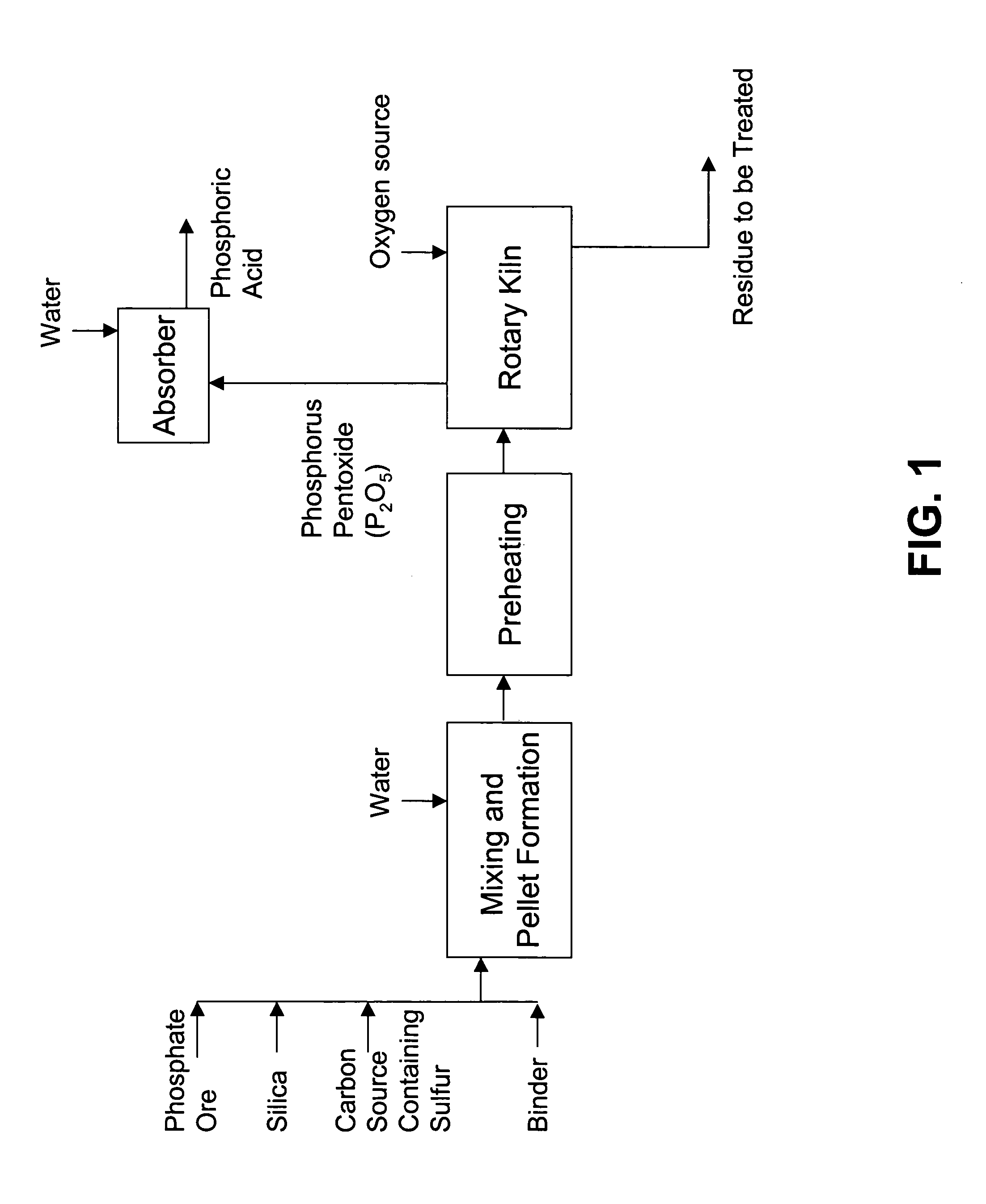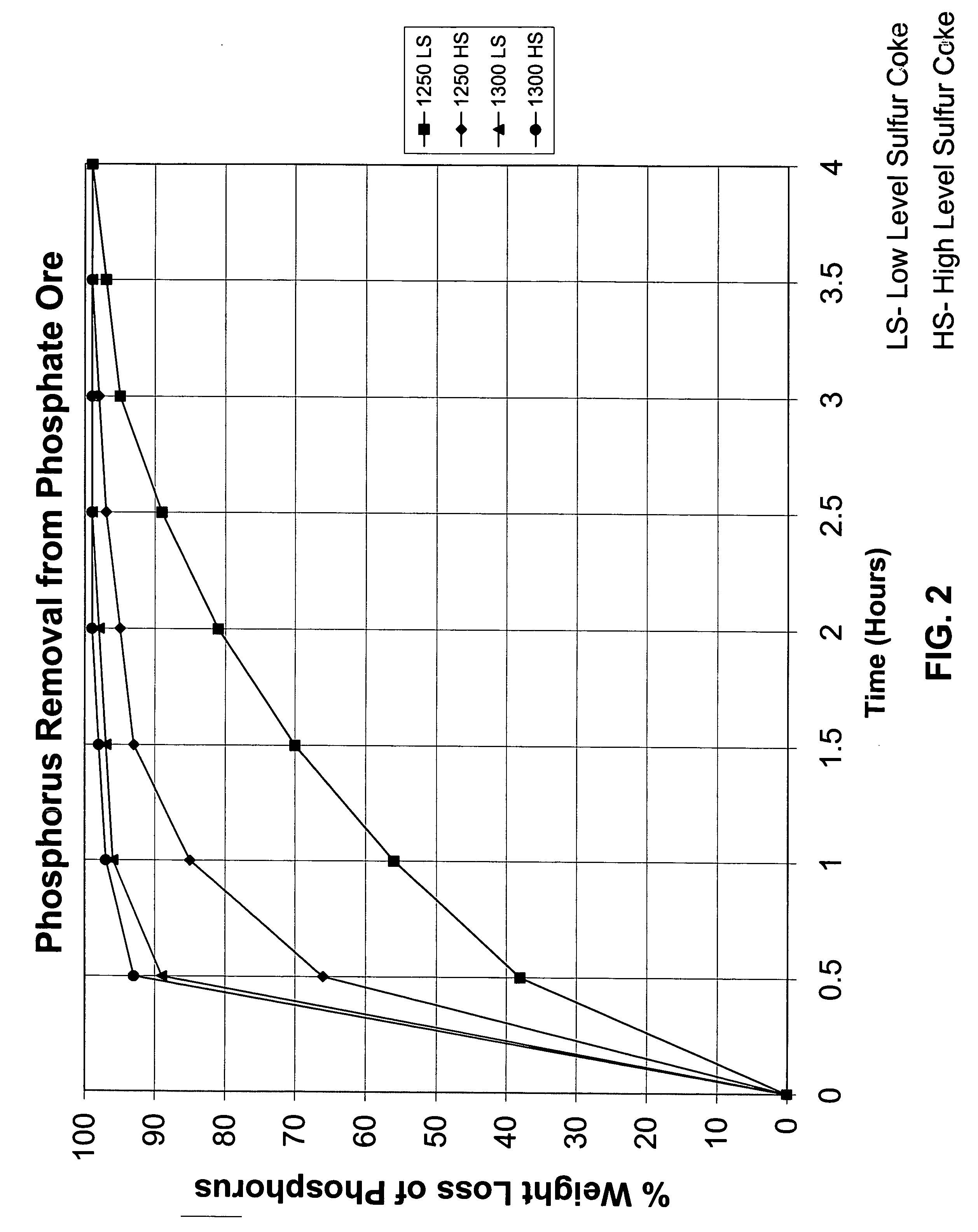Method of forming phosphoric acid from phosphate ore
a technology of phosphoric acid and phosphate ore, which is applied in the field of processing of phosphate ore, can solve the problems of high cost of the food grade acid produced by the thermal grade phosphoric acid process does not meet the food grade specifications
- Summary
- Abstract
- Description
- Claims
- Application Information
AI Technical Summary
Benefits of technology
Problems solved by technology
Method used
Image
Examples
example 1
In one example of the present invention, the material mix contained 68.8% phosphate ore, 7.8% silica, and 23.4% petroleum coke. The phosphate ore as analyzed contained 40.51% CaO, 24.05% P2O5, 11.75% SiO2, 3.5% MgO, and 2.8% Fluorine. The silica contained 98% SiO2. The petroleum coke had a fixed carbon content of 85.5% and 7% sulfur. The ore mix was grounded to where 75% of the mix passed a 200-mesh screen. These materials were blended with 15 parts of water and extruded in a bench scale extruder into ¼ inch diameter pellets of about {fraction (3 / 8)} inch length. The pellets were dried overnight in an oven maintained at 210° F. The dried pellets were placed in a 100 ml crucible and placed in an electric furnace. The following results were obtained and plotted on a graph (see figure No. 2).
Time Held at Temp. -Temperature - ° C.Hours% Phosphorus Removal1250296.61250398.81300197.7
example 2
In this test the petroleum coke was reduced to 80% of that used in Example 1. The formulation contained 72.12% phosphate ore, 8.24% silica, and 19.04% petroleum coke contains 7% sulfur. The results were as follows:
TemperatureOrePet CokeTime at Temp.% PhosphateMeshMesh° C.HoursRemoved2001501250184.120015012502None Detected2001501300196.720015013002None Detected15015013001None Detected15015013002None Detected
These results showed that a coarser grind of ore and reduction of petroleum coke gave similar results. This allows lower use of energy for grinding. A further reduction of petroleum coke resulted in marked reduction of mechanical strength of the pellets together with melting.
example 3
In a series of laboratory furnace tests, phosphate ore, silica, and petroleum coke were formulated into pellets to determine the effect on efficiently of phosphate reduction at a temperature of 1250° C. and a retention time of 2.5 hours by varying the lime (CaO) to silica (SiO2) ratio. The ratio was varied over a range of 1.75 to 0.33 of lime to one of silica. Five tests were made to compare the efficiency of petroleum coke containing 7% sulfur as a reducing agent with that of activated carbon having no sulfur. The phosphate ore had the following composition: 37.9% CaO, 24.3% P2O5, 18.1% SiO2, 3.8% MgO, and 3.0% F. The results were as follows;
Percent Phosphorus RemovedPetroleum Coke withActivated CarbonCa / SiO2 Ratio7% Bound SulfurNo Sulfur1.7591.349.21.2588.984.21.0099.299.00.751001000.33100100
These tests indicate that phosphorus ore reduction becomes more efficient as the silica content in the pellet formulation increases. In other words, the lower the CaO / SiO2 ratio, the highe...
PUM
| Property | Measurement | Unit |
|---|---|---|
| temperature | aaaaa | aaaaa |
| weight ratio | aaaaa | aaaaa |
| temperature | aaaaa | aaaaa |
Abstract
Description
Claims
Application Information
 Login to View More
Login to View More - R&D
- Intellectual Property
- Life Sciences
- Materials
- Tech Scout
- Unparalleled Data Quality
- Higher Quality Content
- 60% Fewer Hallucinations
Browse by: Latest US Patents, China's latest patents, Technical Efficacy Thesaurus, Application Domain, Technology Topic, Popular Technical Reports.
© 2025 PatSnap. All rights reserved.Legal|Privacy policy|Modern Slavery Act Transparency Statement|Sitemap|About US| Contact US: help@patsnap.com


